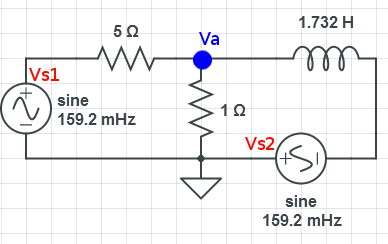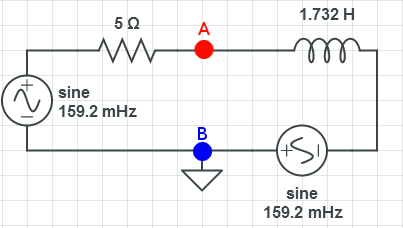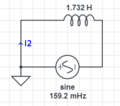




The series components can be lumped together .. which simplifies the circuit a bit.

File:Example70mupad.pngmupad and matlab code for all the work below






Solving

Which is the same as the voltage through the 1 ohm resistor.

Make ground the negative side of  , then:
, then:



Solving




short voltage sources, open current sources, remove load and find impedance where the load was attached

check

yes! they match
Evaluate Thevenin Equivalent Circuit[edit | edit source]

Going to find current through the resistor and compare with mesh current

yes! they match
Find Load value for maximum power transfer[edit | edit source]

Find average power transfer with Load that maximizes[edit | edit source]



The circuit was simulated. A way was found to enter equations into the voltage supply parameters which improves accuracy:
To compare with the results above, need to translate the current and voltage through the resistor into the time domain.
Period looks right about 6 seconds ... should be:

Current through 1 ohm resistor, once moved into the time domain (from the above numbers) is:

From the mesh analysis, the current's through both sources were computed:

The magnitudes are accurate, they are almost π out of phase which is can be seen on the simulation.
The voltage is the same as the current through a 1 ohm resistor:

The voltage of the first (left) source is:

The magnitudes match. The voltage through the source peaks before the current because the first source sees the inductor.
The voltage through the resistor should peak about 171 - 45 = 126° before the source ... which it appears to do.







































